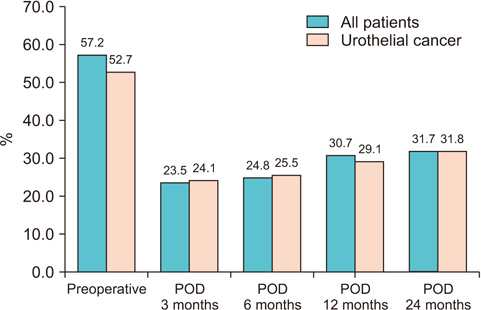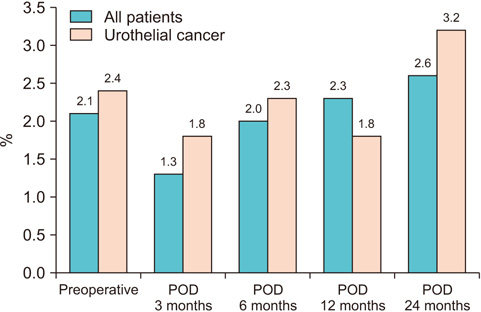Rate and association of lower urinary tract infection with recurrence after transurethral resection of bladder tumor
- Affiliations
-
- 1Department of Urology, Seoul National University Hospital, Seoul, Korea. drboss@snuh.org
- 2Department of Urology, Korea University Ansan Hospital, Korea University College of Medicine, Ansan, Korea.
- KMID: 2399259
- DOI: http://doi.org/10.4111/icu.2018.59.1.10
Abstract
- PURPOSE
To evaluate the rate of pyuria and bacteriuria after transurethral resection of bladder tumor (TURBT).
MATERIALS AND METHODS
We retrospectively evaluated data obtained from 363 patients who underwent TURBT between October 2012 and December 2013 at Seoul National University Hospital. Urinalysis and urine culture were assessed at 3, 6, 12, and 24 months postoperatively. Primary endpoint was the rate of bacteriuria (≥105/mL in a midstream) and pyuria (white blood cells ≥5/high-power field).
RESULTS
We analyzed 306 patients who were eligible for the study. Pyuria was present in 23.5% of patients in the 3rd postoperative month and in 31.7% of patients in the 24th postoperative month. Bacteriuria was present in 1.3% of patients in the 3rd postoperative month and in 2.6% of patients in the 24th postoperative month. Among urothelial carcinoma patients (n=220), 24.1% showed pyuria and 1.8% showed bacteriuria at the 3rd postoperative month. We found that 31.8% showed pyuria and 3.2% showed bacteriuria at the 24th postoperative month. There was no significant difference in the rate of pyuria and bacteriuria between the intravesical treatment group and the no-treatment group. Multivariate analysis demonstrated that pyuria in the 3rd postoperative month (odd ratio [OR], 2.254; p=0.039), tumor multiplicity (OR, 3.331; p=0.001), and the absence of intravesical treatment (OR, 4.927; p=0.001) increases the risk of tumor recurrence.
CONCLUSIONS
A significant proportion of patients showed pyuria after TURBT during the follow-up period. Additionally, presence of pyuria in the short-term follow-up period after TURBT constitutes a risk factor for recurrence of bladder cancer.
Keyword
MeSH Terms
Figure
Cited by 2 articles
-
Establishment of the Seoul National University Prospectively Enrolled Registry for Genitourinary Cancer (SUPER-GUC): A prospective, multidisciplinary, bio-bank linked cohort and research platform
Chang Wook Jeong, Jungyo Suh, Hyeong Dong Yuk, Bum Sik Tae, Miso Kim, Bhumsuk Keam, Jin Ho Kim, Sang Youn Kim, Jeong Yeon Cho, Seung Hyup Kim, Kyung Chul Moon, Gi Jeong Cheon, Ja Hyeon Ku, Hyeon Hoe Kim, Cheol Kwak
Investig Clin Urol. 2019;60(4):235-243. doi: 10.4111/icu.2019.60.4.235.Preoperative sterile pyuria as a prognostic biomarker for intravesical recurrence in upper urinary tract urothelial carcinoma
Byeong Jo Jeon, Bum Sik Tae, Hoon Choi, Jae Hyun Bae, Jong Wook Kim, Hong Seok Park, Jae Young Park
Investig Clin Urol. 2020;61(1):51-58. doi: 10.4111/icu.2020.61.1.51.
Reference
-
1. Haresh KP, Julka PK, Sharma DN, Rath GK, Prabhakar R, Seth A. A prospective study evaluating surgery and chemo radiation in muscle invasive bladder cancer. J Cancer Res Ther. 2007; 3:81–85.
Article2. Joung JY, Lim J, Oh CM, Jung KW, Cho H, Kim SH, et al. Current trends in the incidence and survival rate of urological cancers in Korea. Cancer Res Treat. 2017; 49:607–615.
Article3. Divrik RT, Sahin AF, Yildirim U, Altok M, Zorlu F. Impact of routine second transurethral resection on the long-term outcome of patients with newly diagnosed pT1 urothelial carcinoma with respect to recurrence, progression rate, and disease-specific survival: a prospective randomised clinical trial. Eur Urol. 2010; 58:185–190.
Article4. Hall MC, Chang SS, Dalbagni G, Pruthi RS, Seigne JD, Skinner EC, et al. Guideline for the management of nonmuscle invasive bladder cancer (stages Ta, T1, and Tis): 2007 update. J Urol. 2007; 178:2314–2330.
Article5. Thrasher JB, Crawford ED. Complications of intravesical chemotherapy. Urol Clin North Am. 1992; 19:529–539.
Article6. Abrams P, Andersson KE, Birder L, Brubaker L, Cardozo L, Chapple C, et al. Fourth International Consultation on Incontinence Recommendations of the International Scientific Committee: evaluation and treatment of urinary incontinence, pelvic organ prolapse, and fecal incontinence. Neurourol Urodyn. 2010; 29:213–240.
Article7. Zhang Z, Cao Z, Xu C, Wang H, Zhang C, Pan A, et al. Solifenacin is able to improve the irritative symptoms after transurethral resection of bladder tumors. Urology. 2014; 84:117–121.
Article8. Hansson S, Jodal U, Lincoln K, Svanborg-Edén C. Untreated asymptomatic bacteriuria in girls: II--effect of phenoxymethylpenicillin and erythromycin given for intercurrent infections. BMJ. 1989; 298:856–859.
Article9. Cai T, Mazzoli S, Mondaini N, Meacci F, Nesi G, D'Elia C, et al. The role of asymptomatic bacteriuria in young women with recurrent urinary tract infections: to treat or not to treat? Clin Infect Dis. 2012; 55:771–777.
Article10. Raz R. Asymptomatic bacteriuria. Clinical significance and management. Int J Antimicrob Agents. 2003; 22:Suppl 2. 45–47.
Article11. Cai T, Verze P, Brugnolli A, Tiscione D, Luciani LG, Eccher C, et al. Adherence to European association of urology guidelines on prophylactic antibiotics: an important step in antimicrobial stewardship. Eur Urol. 2016; 69:276–283.
Article12. Jiménez-Pacheco A, Lardelli Claret P, López Luque A, Lahoz-García C, Arrabal Polo MA, Nogueras Ocaña M. Randomized clinical trial on antimicrobial prophylaxis for flexible urethrocystoscopy. Arch Esp Urol. 2012; 65:542–549.13. Arrabal-Polo MA, Cano-García MDC, Arrabal-Martín M, Merino-Salas S. The effect of antibiotic prophylaxis on post-operative infection in patients undergone flexible cystos-copy. Urol J. 2017; 14:3050–3053.14. Herr HW. Should antibiotics be given prior to outpatient cystoscopy? A plea to urologists to practice antibiotic stewardship. Eur Urol. 2014; 65:839–842.
Article15. Azuma T, Nagase Y, Oshi M. Pyuria predicts poor prognosis in patients with non-muscle-invasive bladder cancer. Clin Genitourin Cancer. 2013; 11:331–336.
Article16. Satake N, Ohno Y, Nakashima J, Ohori M, Tachibana M. Prognostic value of preoperative pyuria in patients with non-muscle-invasive bladder cancer. Int J Urol. 2015; 22:645–649.
Article17. Babjuk M, Böhle A, Burger M, Capoun O, Cohen D, Compérat EM, et al. EAU guidelines on non-muscle-invasive urothelial carcinoma of the bladder: update 2016. Eur Urol. 2017; 71:447–461.
Article18. Jablonska J, Leschner S, Westphal K, Lienenklaus S, Weiss S. Neutrophils responsive to endogenous IFN-beta regulate tumor angiogenesis and growth in a mouse tumor model. J Clin Invest. 2010; 120:1151–1164.19. Liang S, Sharma A, Peng HH, Robertson G, Dong C. Targeting mutant (V600E) B-Raf in melanoma interrupts immunoediting of leukocyte functions and melanoma extravasation. Cancer Res. 2007; 67:5814–5820.
Article20. Poletajew S, Zapała P, Radziszewski P. Safety and efficacy of intravesical Bacillus Calmette-Guérin immunotherapy in patients with non-muscle-invasive bladder cancer presenting with asymptomatic bacteriuria: a systematic review. Urol Int. 2017; 99:1–5.
Article21. Bilbao M, Spaniol A, Bearss J, Schellhase C, Shippey S, Aungst M. Histology surrounding cystotomy healing in a Sprague-Dawley rat model. Int Urogynecol J. 2014; 25:97–101.
Article22. Baskin LS, Sutherland RS, Thomson AA, Nguyen HT, Morgan DM, Hayward SW, et al. Growth factors in bladder wound healing. J Urol. 1997; 157:2388–2395.
Article23. Wishnow KI, Johnson DE, Grignon DJ, Cromeens DM, Ayala AG. Regeneration of the canine urinary bladder mucosa after complete surgical denudation. J Urol. 1989; 141:1476–1479.
Article24. Anderson GG, Palermo JJ, Schilling JD, Roth R, Heuser J, Hultgren SJ. Intracellular bacterial biofilm-like pods in urinary tract infections. Science. 2003; 301:105–107.
Article25. Schilling JD, Hultgren SJ. Recent advances into the pathogenesis of recurrent urinary tract infections: the bladder as a reservoir for uropathogenic Escherichia coli. Int J Antimicrob Agents. 2002; 19:457–460.
Article26. Birder LA, de Groat WC. Mechanisms of disease: involvement of the urothelium in bladder dysfunction. Nat Clin Pract Urol. 2007; 4:46–54.
Article
- Full Text Links
- Actions
-
Cited
- CITED
-
- Close
- Share
- Similar articles
-
- The Significance of Simultaneous Transurethral Resection of Bladder Tumor and the Prostate in Patient who have Superficial Bladder Cancer with Bladder Outlet Obstruction
- Risk factors and survival in patients with recurrence of bladder tumors following surgery for transitional cell carcinoma of the upper urinary tract
- Intraoperative ventilation and hemodynamic change due to bladder perforation during transurethral resection of a bladder tumor: A case report
- Prophylactic Measure of Urinary Infection in Transurethral Resection
- Transurethral Resection Syndrome Caused by Bladder Perforation during Transurethral Resection of Bladder Tumor: A Report of 2 Cases



